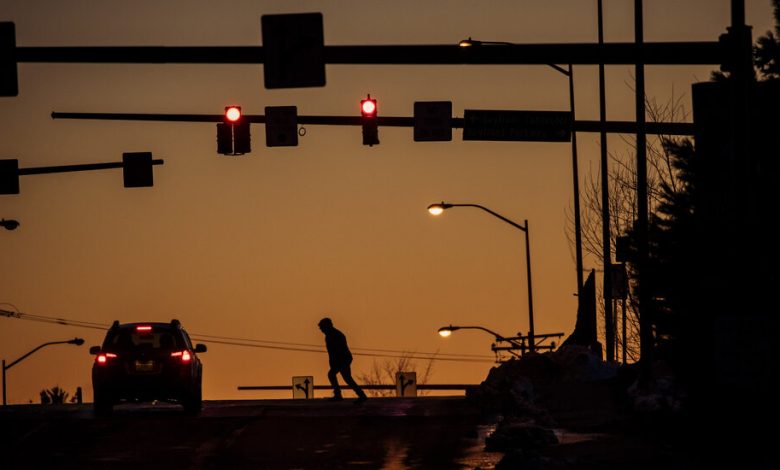The Main Problem With Pedestrian Deaths Isn’t the Pedestrians

I want to talk about two things that have happened since last weekend’s newsletter on pedestrian deaths. One of them was covered in this newspaper, and the other was a personal experience.
The news item is that a young child was killed in Brooklyn this week, struck by a tow truck while crossing a street — at a marked crosswalk — with his mother. According to witnesses, the driver was rushing to beat a yellow light. The police said Friday that the driver was charged with “failure to yield to a pedestrian and failure to exercise due care.”
The personal item is that, while riding my bike to the gym, I was nearly struck by an S.U.V. that ran a red light in order to make a left turn into traffic. Had I been a little less attentive to my surroundings, I may not have been able to avoid a serious collision.
I mention these two things because many of you responded to last week’s newsletter on pedestrian deaths. Some of you relayed stories of collisions and near-collisions as pedestrians and as cyclists. Some of you spoke to the problems I identified in the piece: the proliferation of large, dangerous vehicles, the lack of serious traffic enforcement, and an apparent increase in speeding and distracted driving. And some of you argued that the issue had as much to do with irresponsible pedestrians and cyclists as it did with irresponsible drivers and the transportation infrastructure of our cities.
Now, there is some data we can bring to bear on this question. According to a study from the Florida Department of Transportation, cyclists and drivers comply with traffic laws at about the same rate: 88 percent for the former versus 85 percent for the latter. And according to a 2020 study by Rutgers University on pedestrian accidents, distracted walking factors into a relatively small share of crashes, between an estimated 5 and 10 percent of the total. If cyclists are scofflaws and pedestrians are uniformly distracted by phones, it’s not yet showing up in the research.
But the point I want to make is not that there’s no evidence to suggest that cyclists and pedestrians are unusually transgressive or inattentive, but that the focus on their behavior is besides the point.
The most dangerous things on our streets are cars and trucks, multi-ton chunks of metal, glass and plastic designed to move at high speeds through urban and suburban environments that are, more often then not, designed for the flow of vehicles rather than the movement of people. Nearly everything about our transportation infrastructure exists to tell drivers that they have pride of place on our roads and streets, and that their convenience is more important than any other consideration. And too many drivers have gotten the message, ignoring any responsibility to those outside their vehicle in favor of whatever behavior allows them to make the fastest journey from point A to point B.
The rise in pedestrian and cyclist deaths is first and foremost a product of design: design of cities, design of our streets, design of our vehicles. To the extent that we can trace it to behavior, it is behavior that has been inculcated by those design choices. But even if there are behavioral flaws to find as everyone moves around outdoors — drivers, cyclists and pedestrians alike — the consequences of scofflaw behavior from drivers are simply much greater, and much worse, than the consequences of scofflaw behavior from other people on the street.
The problem, ultimately, is about cars and trucks. And the focus, ultimately, should be on cars and trucks.
What I Wrote
My Tuesday column was on voting, partisanship and generational change.
My Friday column was on the new speaker of the House, Mike Johnson of Louisiana, and what his ascent says about the present trajectory of the Republican Party.
And in the most recent episode of my podcast with John Ganz, we covered “The Enemy Within,” a 1994 remake of John Frankenheimer’s 1964 film “Seven Days in May.”
Now Reading
Jonathan M. Katz on Zionism for his Substack newsletter.
Adam Shatz on Israel, Palestine, memory and violence for the London Review of Books. (I recommend you read everything in this section this week but this piece, especially, is wide-ranging and powerful and worth your time and attention.)
Saree Makdisi on who gets to be human for n+1 magazine.
Y. L. Al-Sheikh and Abe Silberstein make the case for a cease-fire at Dissent.
Fintan O’Toole on the language of “civilization” for The New York Review of Books.
Photo of the Week
This is a pop-art inspired mural I saw in Montreal over the summer, and I like it quite a bit.
Now Eating: Big Pot of Beans
I was in the mood for just a pot of brothy beans for dinner last night, and that’s what I made. I have my own approach for making beans, but in the spirit of synergy with The New York Times’ Cooking Section, I thought I would share this recipe for basic beans from Melissa Clark. I brine dry beans in salt and baking soda before cooking. This is optional! You can use dried beans straight from the bag if you’d like, just be sure to wash them and pick out any debris.
You can add any aromatics you’d like to the beans as well. If you eat meat, then a little cured sausage or bacon or smoked turkey necks is excellent. If you don’t, then dried mushrooms or kombu or a parmesan rind will add the necessary umami. I like to go heavy on the garlic but again, you should do whatever you’d like. The fun part of a pot of beans is garnishing your bowl. Use plenty of fresh herbs and grated cheese and even a bit of olive oil. Serve with whatever bread is appropriate. My beans were Mexican-inspired, so I made fresh tortillas with red corn masa from Masienda.
Ingredients
-
1 pound any dried beans
-
Salt
-
Olive oil, as needed
-
Aromatics, such as peeled garlic cloves, a halved onion or shallots, a celery stalk or a carrot
-
Dried or fresh herbs, such as thyme, sage, oregano or rosemary sprigs, or a bay leaf or two
-
A hunk of cured sausage, bacon, ham, smoked duck or pork or a Parmesan rind (optional)
-
Chopped fresh herbs or celery leaves, red-pepper flakes, sliced scallion or red onion, flaky sea salt, for serving (optional)
Directions
Rinse the beans, then soak them in salted water (it should taste like the sea) for anywhere from four hours to 12 hours. If you don’t have time, you can skip this step.
Drain beans and put them in a pot or electric pressure cooker. If cooking in a regular pot, add enough water to cover the beans by two to three inches. If using a pressure cooker, use less water, more like 1½ to two inches. Add a drizzle of oil and whatever aromatics and herbs you like.
If using a regular pot, simmer the beans for anywhere to 30 minutes to two to three hours, depending on what variety you used, how old they were and whether or not you soaked them. Check on them periodically, adding more water if the level gets too low (as in, lower than the beans). For the pressure cooker, the timing is anywhere from five minutes at high pressure to 50 minutes. Let the pressure release naturally.
Garnish with fresh herbs or celery leaves, sliced onion, if you like, a drizzle of oil, and a sprinkle of red-pepper flakes and sea salt.



